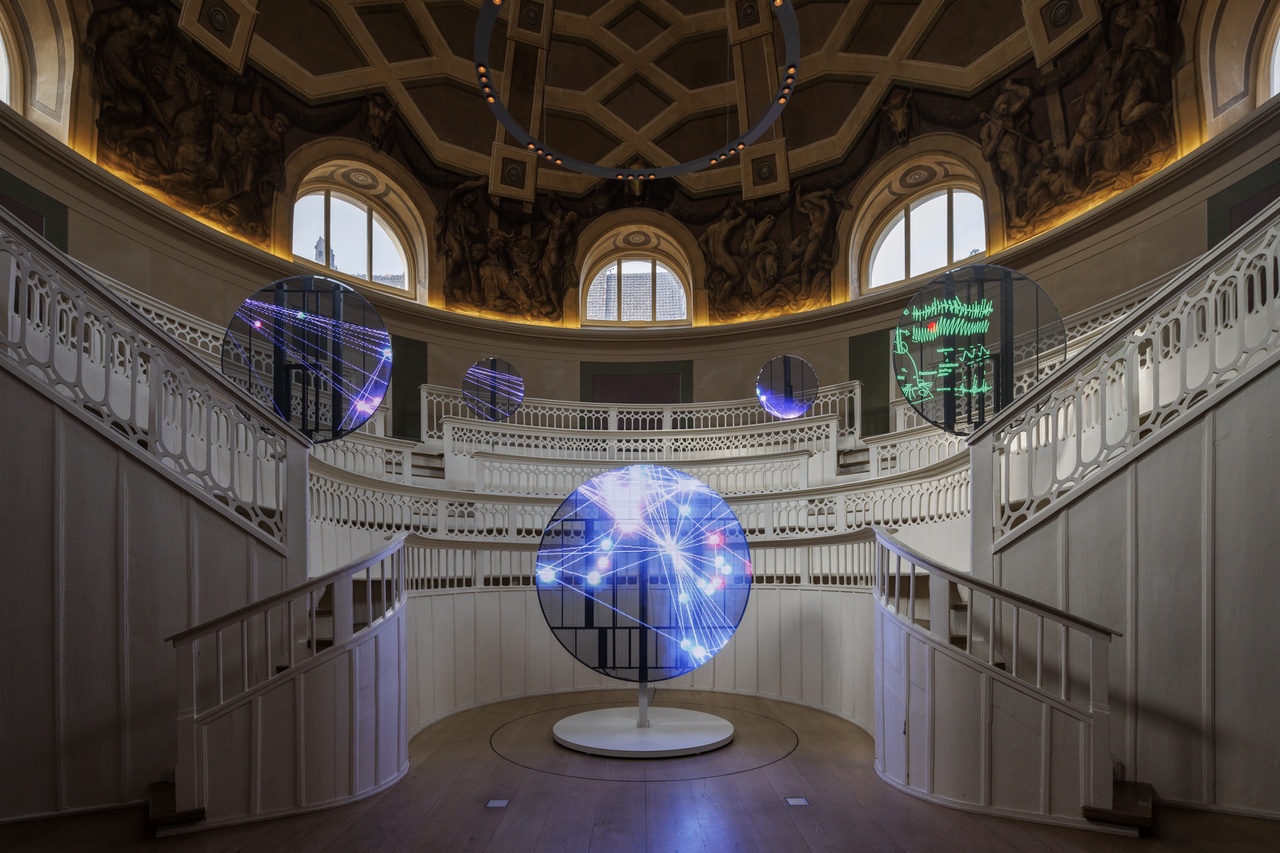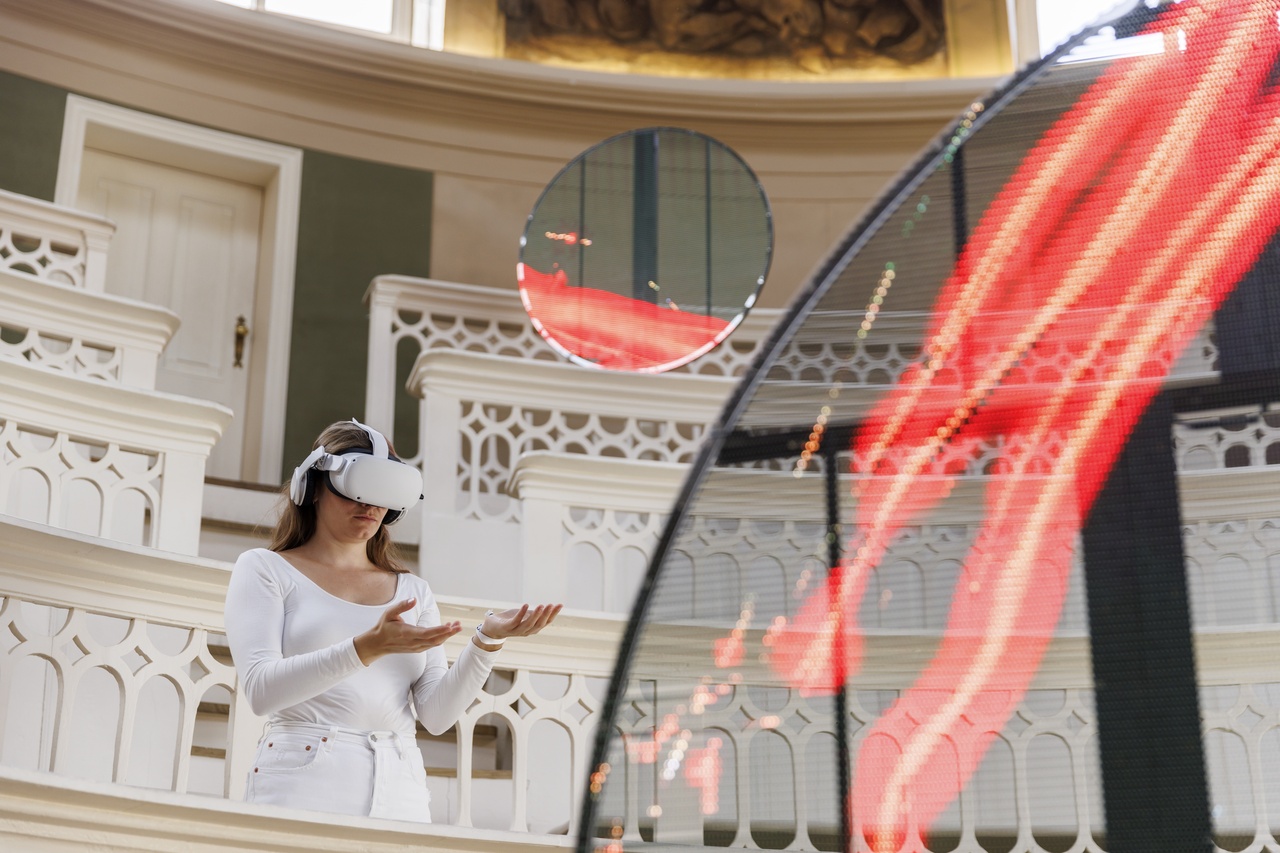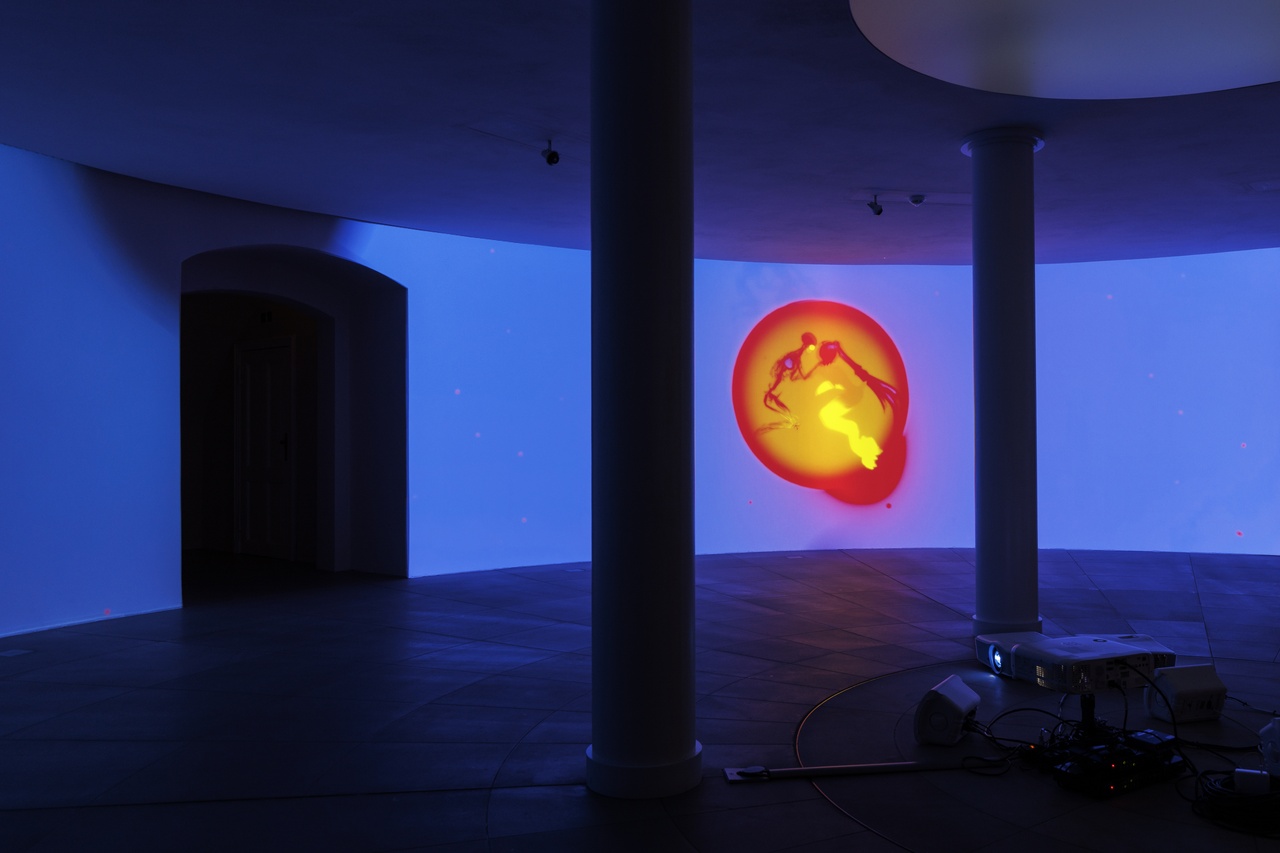ANATOMY OF THE DIGITAL Jeffrey West Kirkwood on Rachel Rossin at Kunstwerke Berlin

“Rachel Rossin: The Maw Of”, KW Institute for Contemporary Art at Tieranatomisches Theater, Berlin, 2022, installation view
Late in the spring of 2022, Blake Lemoine, a software engineer working with the Responsible AI team at Google, claimed that the system was “sentient” and “a sweet kid who just wants to help the world be a better place for all of us.” [1] He had also attempted to teach it “transcendental meditation,” a practice at which he said it was “making slow and steady progress.” [2] Google fired him.
The idea that contemporary technologies have evolved to replicate, reproduce, and ultimately displace human intelligence is in many ways an artifact of quasi-religious ontologies of machines. These are dogmas that seek to essentialize technologies through concepts of consciousness, life, and Geist. It’s not an accident, then, that Lemoine is also an ordained Christian mystic priest and that similarly archaic forms of spiritualisms have returned to vogue in Silicon Valley. Whether seen as savior or agent of doom, new technologies in this worldview challenge, usurp, or threaten the primacy of human experience because they are understood as essentially distinct from it. This is a mistake.
Where popular discourses on technology often err in their insistence on a tidy machine/human boundary, Rachel Rossin luxuriates in the tangled mess of wires and nerves concealed by slick consumer interfaces. Rossin’s works frequently involve multi-modal installations emphasizing the disparate but inseparable spheres in which digital technologies function – as infrastructure, as code, as hardware, and as experience. She is known for coaxing artistic media like painting, sculpture, and sound into uneasy harmonies with contemporary technological practices related to virtual reality, augmented reality, hardware hacking, blockchain smart contracts, and genetic sequencing. And she does so in ways that refuse the idea that technology merely extends a preestablished set of human faculties. Her most recent exhibition, “The Maw Of,” installed at the KW Institute for Contemporary Art during Berlin Art Week, deepens this sense of a posthumanistic filigree of flesh and technology. It locates the very question of consciousness within a labyrinthine field of technological operations that cannot be distinguished from the body or the innermost experiences that emerge from it.

“Rachel Rossin: The Maw Of”, KW Institute for Contemporary Art at Tieranatomisches Theater, Berlin, 2022, installation view
“The Maw Of” exaggerates to a mind-bending degree the many-faceted deployment of digital technologies that have characterized Rossin’s previous work in pieces like Man Mask (2016) and Skinsuits (2019). The main site of the four-day installation is located in the circular lecture hall of the Tieranatomisches Theater on the northern campus of Humboldt-Universität. Amid the steeply raked array of wooden pew-like seating, images play on large, round, pedestal-mounted dot matrix displays. What first appear to be mere colorfully saturated abstractions on the big LEDs become increasingly familiar as one moves on to the myriad other sites that form the piece. The images will seem to repeat like memories throughout the show, but never with a stable source, identity, association, or even form. They represent the sites of a human-level interaction, but only as epiphenomena of more technical physical hardware that is largely invisible – both in our bodies and in the digital devices that now shape our sense of those bodies’ autonomy, appearance, and past. Whereas the cybernetician Heinz von Foerster commented on the “pathological semantics” of metaphors linking the “mental faculties” of perception, memory, or prediction to a false mechanical equivalent in computers, Rossin’s exhibition pointedly observes how the connection between human and machine is now neither merely semantic nor pathological, but simply a fact. [3]
In the center of the theater’s stage, where a lift would have elevated the bodies of animals for display and dissection, stands another of the screens – substituting the fragmentary body of the animal with a fragmentary image that emerges like a specter from the illuminated dots in the display. The images, much like consciousness, and with it memory and identity, are not pre-constituted or stored whole in any particular place. They surface and resurface as visual unities based on instructions as defined by codes that are equal parts computational, biological, and cultural. This would seem to be a uniquely digital phenomenon, but the selection of the anatomical theater, which is a part of the Hermann von Helmholtz-Zentrum für Kulturtechnik, effectively draws on a tradition of experimental psychology from a 19th century that is not just long, but so long that it touches the contemporary moment. Many of the insights about the connection between the mind and the body that informed the development of neuroscience, cybernetics, and eventually neural networks were initially drawn from observations of animal physiology. Helmholtz himself was one of the first to accurately quantify the propagation of electrical signals in the nervous systems of frogs, with profound implications for the study of neurophysiology and therefore for the mechanical underpinnings of the mind. He was also deeply interested in how the physical processes of binocular vision resolved themselves in a mental image – or the question of mind as a virtual image.
Among the rows of curved, white benches in the theater are Meta Quest 2 VR headsets that are arguably the marquee elements of the show. Unlike many artists working with virtual reality to produce immersive landscapes for viewers to navigate, Rossin uses hand-tracking software and augmented reality that could be described as re-immersive. While it appears that you are looking through the headsets to your hands and the cascading tiers of the theater, the device is actually reconstructing and re-presenting the space and your body’s movements within it. The very experience of your body as an image is shown to be a computational, technical feat whether the hardware be microprocessors or neurons. This was decisively underscored when I couldn’t get my headset to work. According to the technical assistant, the software had difficulty processing the complexity of the many-levelled surfaces of the theater, exposing the really real element of VR, namely its inside-out tracking systems enabled by cameras, accelerometers, and gyroscopes. That much of both the software and the hardware that enable such a virtual experience is propriety – in this case made possible by Meta – invites larger considerations about the invisible capitalist architecture on which the digital’s supposed realism is built.

“Rachel Rossin: The Maw Of”, KW Institute for Contemporary Art at Tieranatomisches Theater, Berlin, 2022, installation view
Once the headset is up and running, shifting visuals move between grainy reproductions of the room and graphs of nameless networks to what look like thermal images of the surroundings. As Rossin noted, she built the heat mapping software from the ground up. It creates the impression of visualizing thermal intensities, when in fact it is a purely visual effect without any correspondence with the physical properties of the objects depicted. This brilliant feint is an instance of the incommensurable mirrorings between media that are a part of much of Rossin’s work – whether UV-printed figures on shaped plexiglass of digital characters in I’m my loving memory (2020–21) or the canary she taught to sing dubstep as a soundtrack to a VR piece in On Sentinels (dubstep) (2021). In each case, the reproduction across biological, computational, and physical platforms demonstrates the singular attributes of each, leaving what Rossin has referred to as a “residue” from each transformation. The result is to put pressure on the image-based interfaces we are accustomed to mistaking for the real, including, perhaps most of all, the interface of human consciousness.
This insight moves into the realm of personal psychology as the images from the LEDs reappear. Floating in the middle distance of the VR headsets, the web-based interface, and a smart phone AR that overlays many of the visuals from the physical installations using your phone’s camera, are scenes and “digital assets” that Rossin has collected since she was fourteen. One of the most recognizable is a “harpy” multiply invoked across her work, which is shown grappling with a hydraulic armature resembling a mechanical gargoyle. Not only is the mythical hybridity of the harpy fused with an additionally inescapable technological hybridity, but it also frames the nature of the artist’s own memory as a digitally reproducible artifact of an external technology. When, in the next instance, the figure is replaced by a small image of a house on fire, the effect is revelatory. One is reminded almost immediately of Sigmund Freud’s early analysis of Dora in 1905, in which she dreams of a house on fire. [4] Where the polyvalence of dream images function for Freud to disguise repressed wishes or unfulfilled intentions whose definite source can never be determined, here there is no unconscious, but instead a host of unseen computational processes that can no longer be thought separate from our psyches.
The relationship between hardware as unconsciousness and interface as consciousness is made undeniable when one ventures into the basement. In a space where animal specimens would have been prepared for dissection, securing a history of psychophysiological experimentation that set a movement in motion toward AI, there is a transparent case housing a series of circuit boards, cables, and microcontrollers arranged to look like a human nervous system. From the peripheries of the serpentine configuration of wires, line couplers, fans, and printed circuit boards extend red lights like sensorial appendages and another tiny screen, once again displaying the harpy image. From this mass of wiring, situated in the architectural and historical unconscious of the digital era, emerges a crude interface repeating our memory from the rest of the show. Continuing still further in the basement, one encounters the final node in the sprawling system: a hive of projectors at the center of a circular room running 360-degree projections of the fake thermal images. Indeed, a panoptic basement, warm from the hum of projection fans casting images of heat intensities corresponding to nothing in reality feels like the right place to conclude, as it’s impossible to get outside of the scene of universal computing that Rossin sets up and finds us all within.
„Rachel Rossin: THE MAW OF", KW Institute for Contemporary Art, Tieranatomisches Theater, Berlin, 15.–18. September 2022.
Jeffrey West Kirkwood is a critic and associate professor of art history at Binghamton University. His latest book is Endless Intervals. He lives in Berlin and New York City.
Image credits: All images courtesy of the artist, photos Frank Sperling
Notes
| [1] | Nitasha Tiku, “The Google Engineer Who Thinks the Company’s AI Has Come to Life,” The Washington Post, June 11, 2022. |
| [2] | Jon Brodkin, “Google Fires Blake Lemoine, the Engineer Who Claimed AI Chatbot Is a Person,” Ars Technica, July 25, 2022, https://arstechnica.com/tech-policy/2022/07/google-fires-engineer-who-claimed-lamda-chatbot-is-a-sentient-person/. |
| [3] | Heinz von Foerster, Understanding Understanding: Essays on Cybernetics and Cognition [1970] (New York: Springer, 2003), 172. |
| [4] | Sigmund Freud, “Fragment of an Analysis of a Case of Hysteria” [1901], in The Standard Edition of the Complete Psychological Works of Sigmund Freud, vol. 7, 1901-1905: A Case of Hysteria, Three Essays on Sexuality and Other Works, trans. and ed. James Strachey (London: Hogarth, 1953), 1–122. |
